Cute, colourful and delicious, Kuih Seri Muka is a salty sweet treat that’s totally moreish! This traditional Nyonya dessert is the perfect combo of coconut rice with a sweet layer of pandan custard.
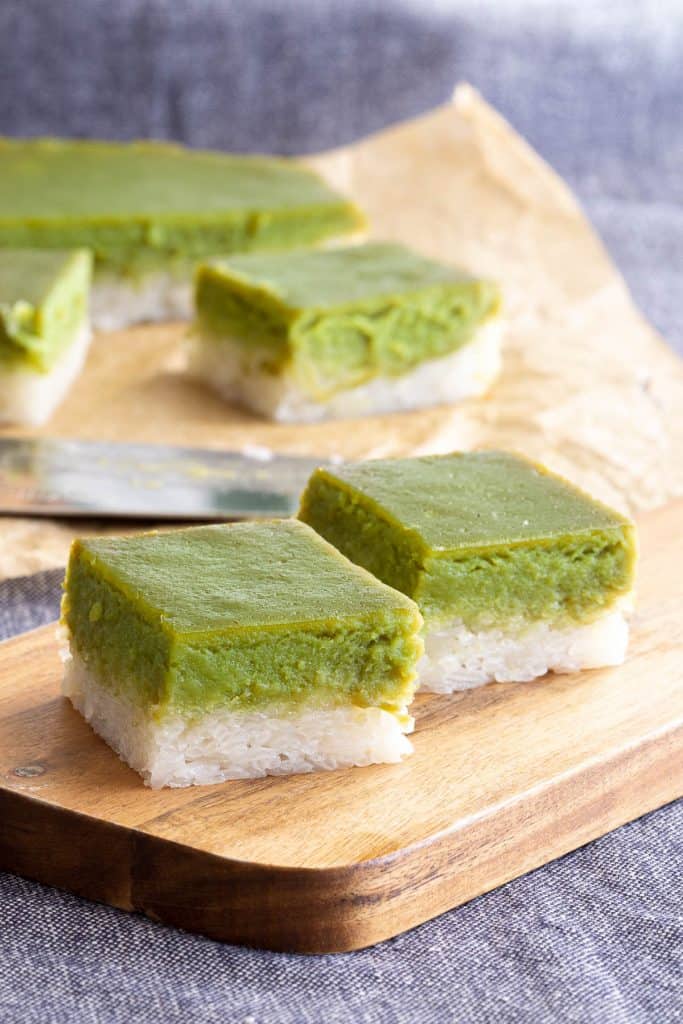
Why We Love This
It’s not easy to find this tasty treat where we live in Australia, so we love being able to make it at home whenever the craving strikes.
This small batch recipe makes the perfect amount, best eaten up within 24 hours. You can double or triple it if you want to serve a crowd.
The flavour combination of salty, sticky coconut rice and sweet custard made with pandan extract or flavouring is so GOOD. You won’t want to stop at one, and we wouldn’t be surprised if the whole batch disappears within the hour.
It’s such a cute little dessert perfect for sharing. Pair with a cup of coffee or tea for an indulgent breakfast or tasty afternoon treat.
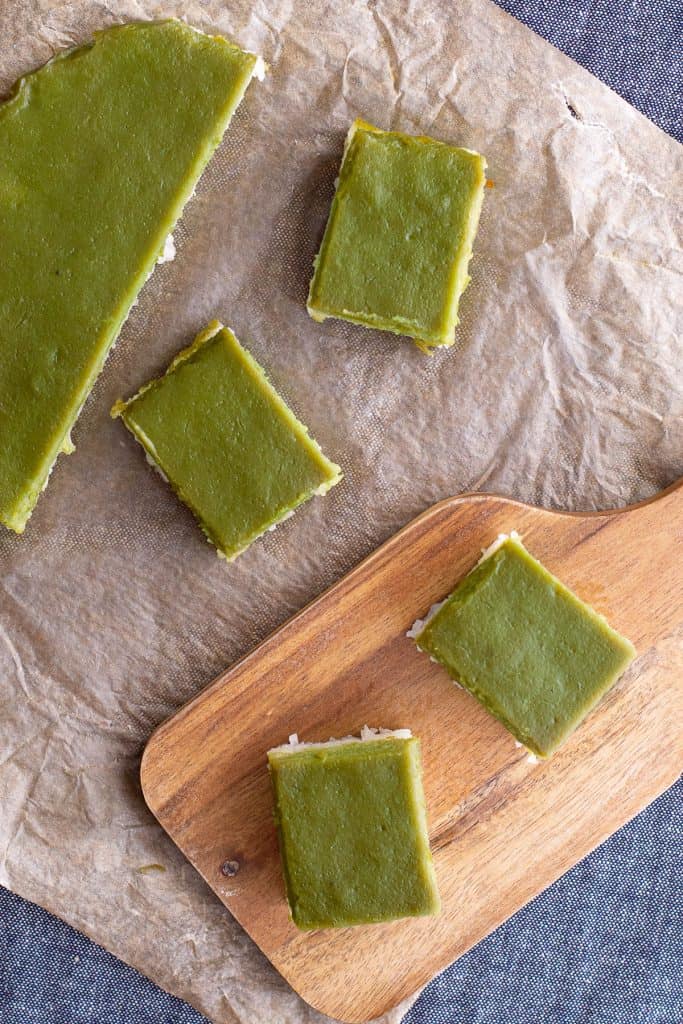
What is Seri Muka?
Seri muka is a type of Southeast Asian dessert that also goes by the name of serimuka or kueh salat. This two layered dessert consists of a layer of sticky rice steamed in salted coconut milk, topped with a layer of egg custard flavoured with fresh pandan extract or artificial pandan flavouring (known as pasta pandan). It originates from the Peranakan / Nyonya cuisine in Malaysia, Indonesia and Singapore.
When they’re not cooked at home, you can find seri muka sold at markets alongside, serabi kuah, dadar gulung and klepon by roaming street food vendors. Usually eaten for breakfast, a snack or even as dessert.
Kuih/kue means ‘cake’, and seri muka means ‘beautiful face’. It’s said that the name comes from the smooth, even presentation of the custard layer on top.
A Note on Presentation
Traditionally, there’s a lot of emphasis on achieving a perfectly smooth appearance on the pandan custard layer of seri muka. If this is important to you, we’ve included a few helpful tips further in this post.
For us, the focus is on having fun in the kitchen and enjoying delicious food. If your seri muka doesn’t look perfect, jangan setres (don’t stress). Bermalas malas (relax) and selamat makan (enjoy your meal).
What You’ll Need
- Glutinous Rice – Also known as Thai sticky rice or sweet sticky rice. Your best source for this will be Asian grocers or online.
- Palm Sugar – We use a type of palm sugar called gula melaka which gives a rich caramel flavour to the custard. It will also affect the colour of the pandan custard layer, making it a darker rich olive green. You can use light brown sugar or regular sugar if you need, and this will give the custard a brighter green.
- Coconut Milk – Look for full-fat canned coconut milk with at least 60% coconut extract which will give you the best flavour and texture.
- Pasta Pandan – This recipe uses pandan flavouring rather than fresh pandan juice as it’s quick and easy to use, and it’s harder to source fresh pandan leaves in Australia. Look for ‘pasta pandan’ (aka pandan paste) at your Asian grocer or buy it online.
- Flour – We use all purpose flour for this recipe. You can substitute with rice flour which is naturally gluten free.
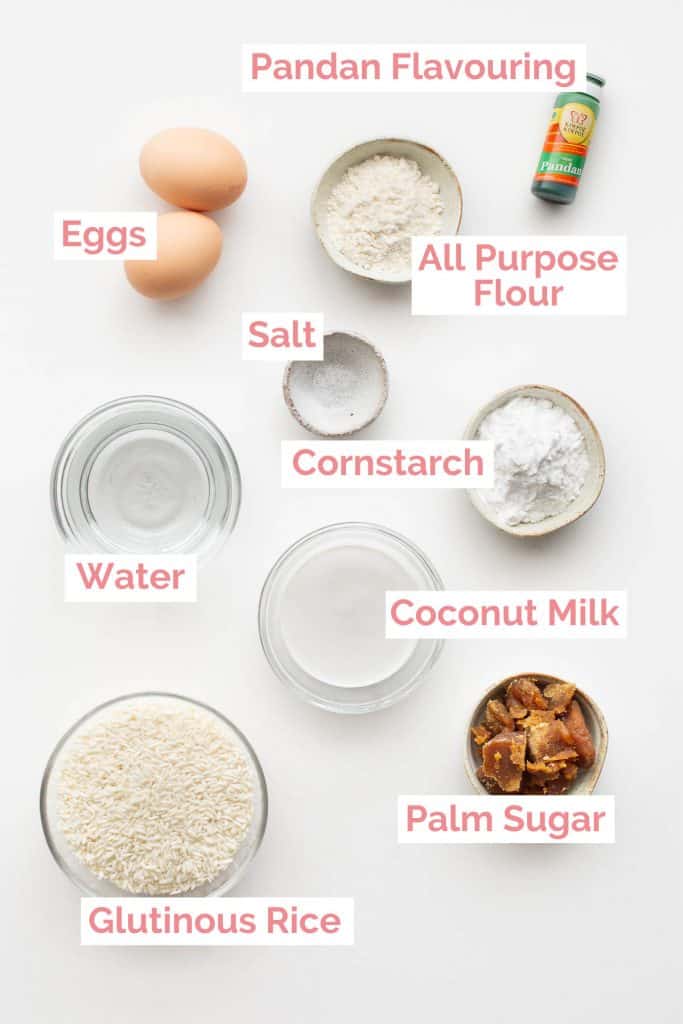
How to make Seri Muka:
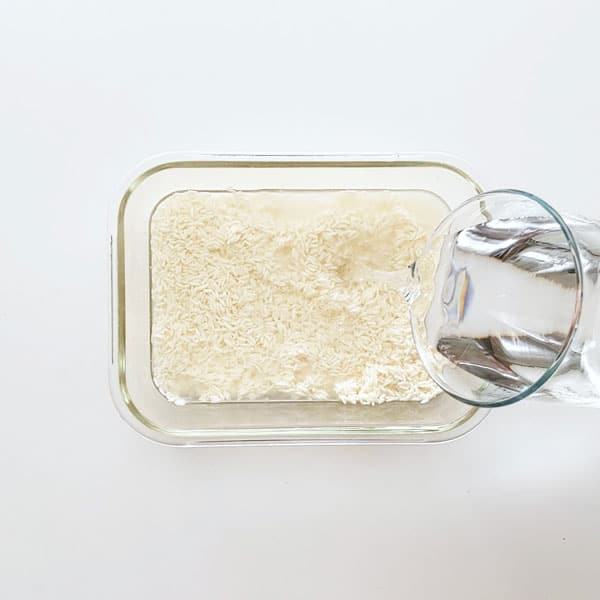
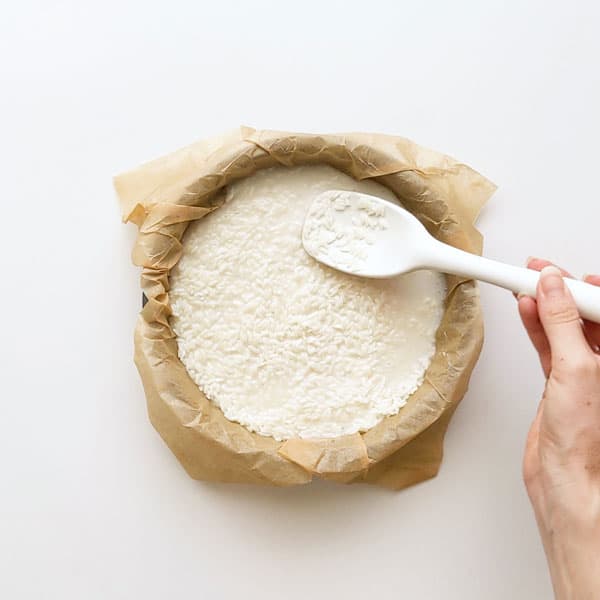
For the coconut rice layer:
- Wash the glutinous rice twice in water, and drain each time. Then cover with water, around 1 inch / 2.5cm above the rice level (as it will expand) and allow to soak for 30 minutes. Drain again.
- Add the coconut milk, 50ml / 1.7floz water and salt to the rice and stir through. Line a 9 inch x 9 inch square or circular baking tray with baking paper and add the rice mixture.
- In a large pot or electric cooker, add 1-2 litres / quarts of water and bring to the boil. Pop the tray on a dish to hold it out of the water, cover with a lid and steam the rice for 35 minutes.
- At the 20 minute mark, start the pandan custard layer.
For the pandan custard layer:
- Pop the palm sugar in a small bowl and zap in the microwave for around 20-30 seconds in 10 second increments. You want to soften the palm sugar, so it melts quickly in the custard.
- Using the double boiler method, fill the bottom of a medium saucepan with water and bring to the boil then turn down to medium heat. Add a metal mixing bowl on top to make the custard.
- Add the water, cornstarch, all purpose flour, eggs, coconut milk, pandan paste and salt into the bowl. Using a whisk, combine until smooth, then add in the chopped palm sugar. Keep mixing quickly, scraping down the sides as you go to avoid the custard clumping. In around 5-10 minutes, the mixture should start to thicken to more of a custard. Remove from the heat at this point while still a little runny.
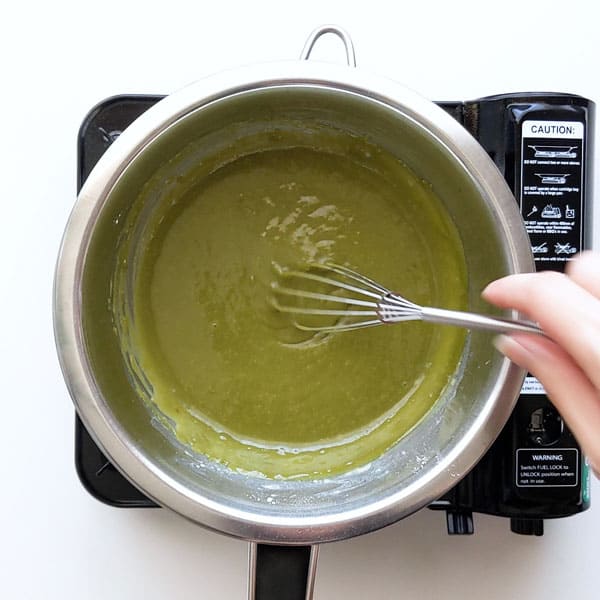
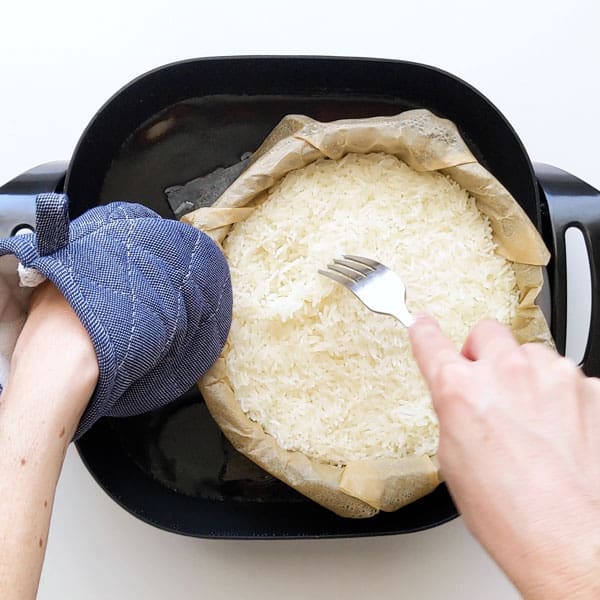
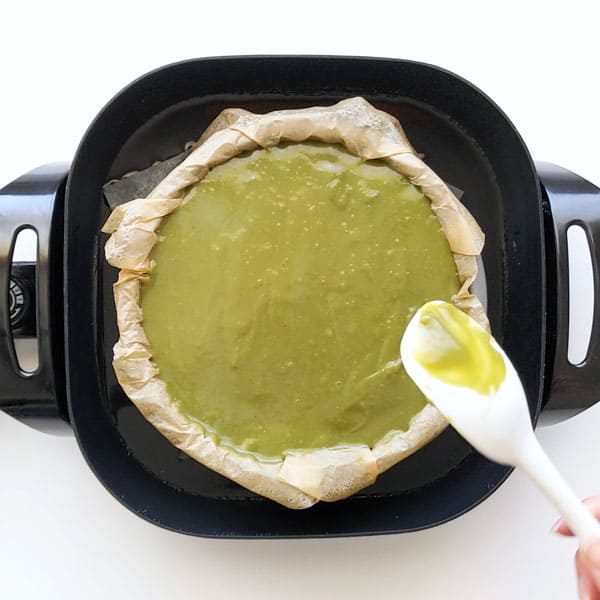
To finish:
- Remove the rice from steaming and fluff the top with a fork (careful not to tear the baking paper). Next, flatten with the back of a spoon until firmly packed down.
- Pour over the pandan custard, and smooth out with the back of a spoon.
- Pop the tray back into the pot or electric cooker, and steam for another 25 minutes.
- Once set, remove from the steamer and set on the bench to cool.
- For best results, allow the kuih seri muka to cool completely before cutting.
Wandercook’s Tips
- Compress the Rice – Once the rice is cooked, press it firmly into the tray to create an even, flat layer. This will help the base hold its shape and help the custard layer stick to it.
- Gently Pour Custard – This avoids extra air bubbles getting trapped in the custard.
- Pop the Bubbles – If you see bubbles on your custard layer (before cooking), you can use a toothpick or skewer to pop them for a more beautiful presentation.
- Cook on Low – Avoid high heat as this can cause bubbles to form in the custard. Be patient and you’ll be rewarded.
- Vent the Steam – To avoid condensation forming, make sure there is a gap so that excess steam can escape the cooker. If your steamer has a vent in the lid, that should be enough. If not, wrap a tea towel around the lid to absorb condensation and stop it dripping on the surface of your custard. This will help give you that beautiful smooth surface.
- To Check Custard Is Cooked – Just like a cake, you can poke a toothpick into the custard and if it comes out clean, it’s done.
- Let it Cool Completely – Seri muka must be completely cool before slicing or popping into a container for storage.
- Wet Knife – Use a wet towel to wipe the knife before and after each slice for nice, even edges and to stop the rice from sticking to the blade.
- Leftover Rice? – Turn it into homemade Thai toasted rice powder for dishes like chicken larb salad.
FAQs
No, glutinous rice is definitely a must, as it will stick together and hold its shape in the final dessert.
Yes, both options will work. Make sure to use a container that will fit inside the bowl of your cooker. We haven’t tested these cookers personally, but assume cooking times will vary when using these methods, so keep an eye on it.
Seri muka is better when not kept in the fridge – so it’s best eaten within 24 hours. If you do want to keep it in the fridge, it will last for up to 3 days. Cover with plastic wrap and place in an airtight container to prevent the glutinous rice layer from drying out and becoming hard and chewy.
We used a 24 cm round 9 in cake dish to fit our frying pan setup as we don’t have a regular steamer. Square trays are better for cutting nice square/diamond shape sizes. Smaller trays works better here, so that you can have nice tall layers. If the tray is too big, the layers will be too short.
As long as you’re steaming over a low heat, it will cook eventually. Try steaming for a bit longer, and make sure there is a gap or vent hole so the steam can escape.
Variations
- Double Pandan – Add a drop or two of pandan flavouring when cooking the glutinous rice so you end up with two green layers.
- Slicing – Slice into squares or diamonds.
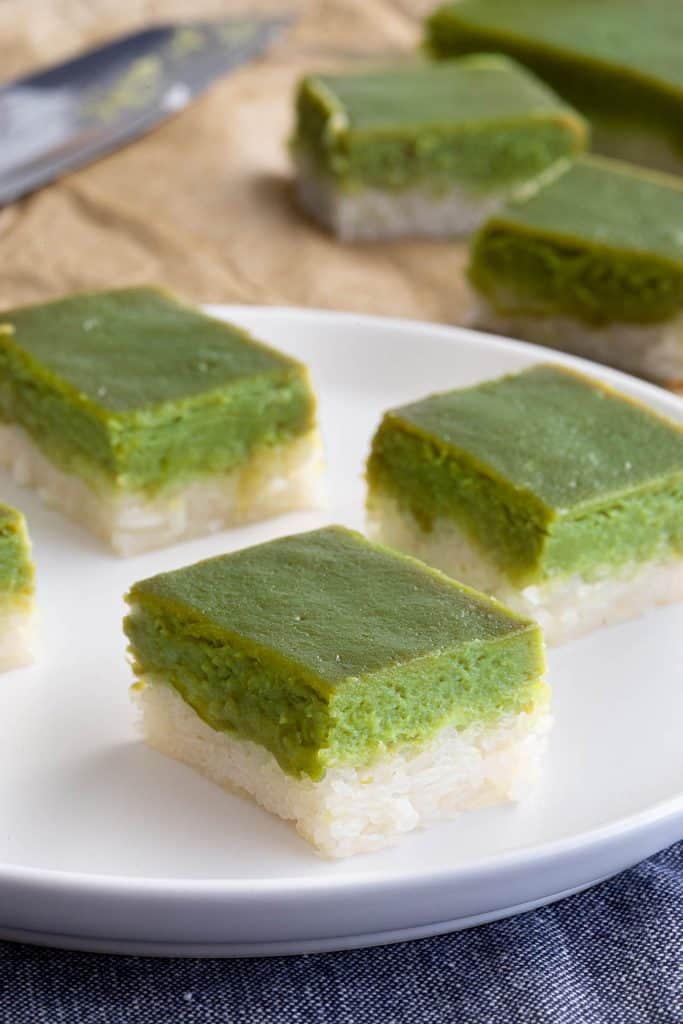
Want more sweet Asian desserts? Try these next:
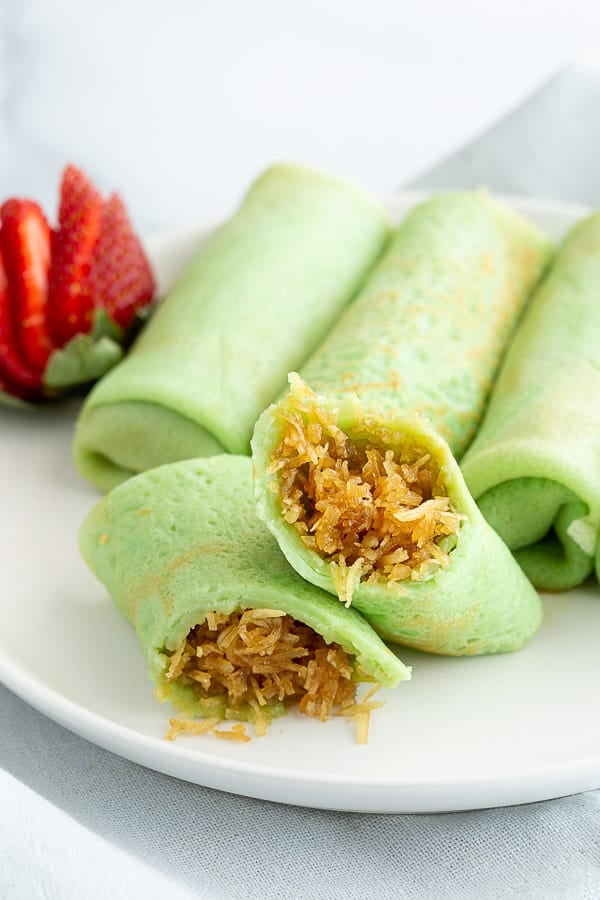
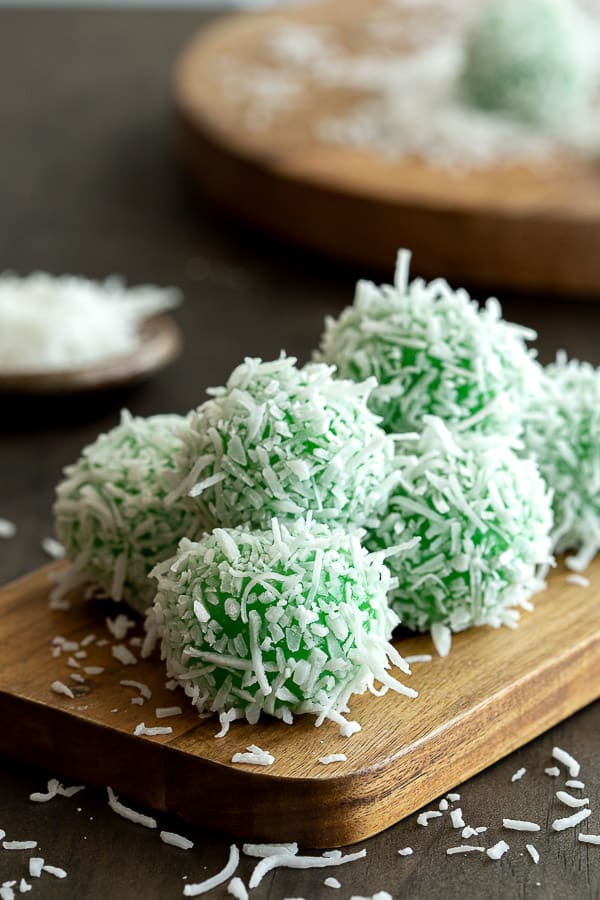
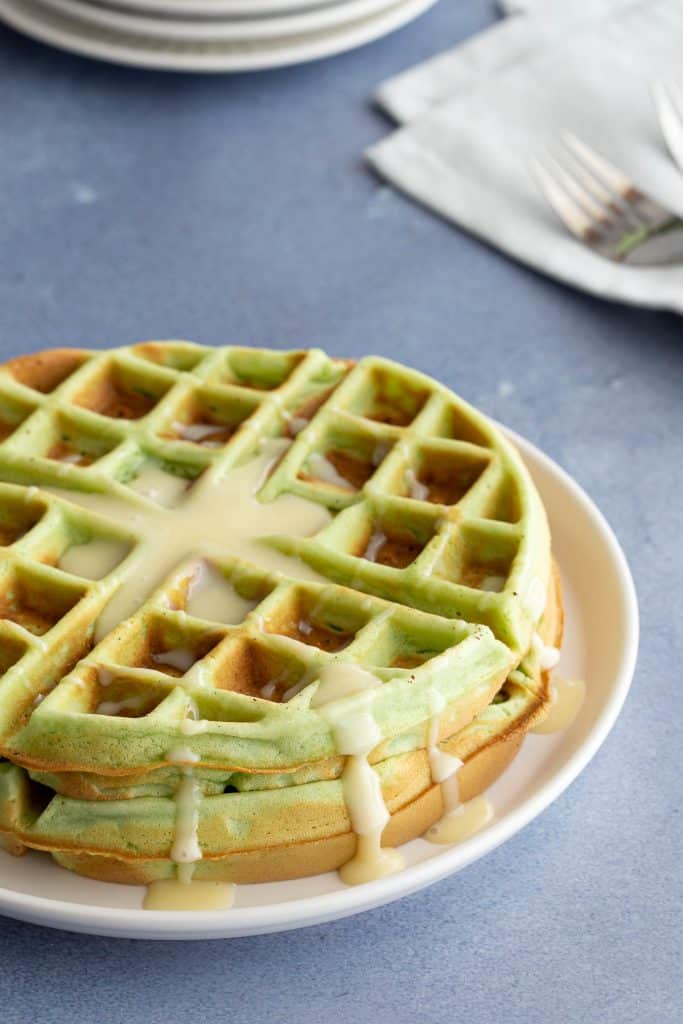
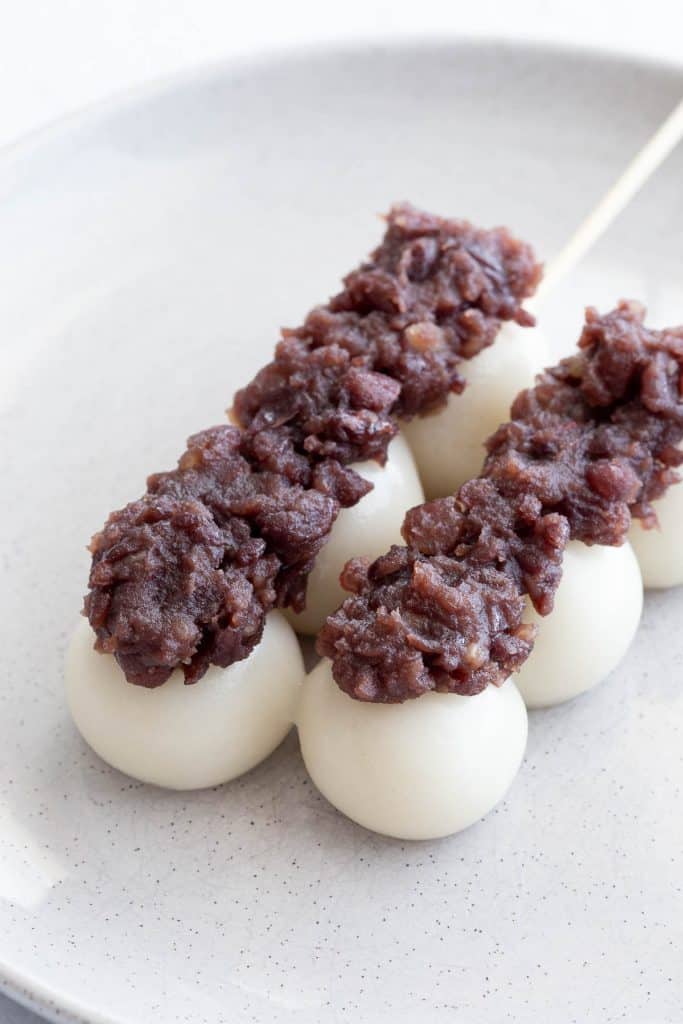
★ Did you make this recipe? Please leave a comment and a star rating below!
Ingredients
For the rice layer:
- 1 cup glutinous rice 200g, 7oz
- 500 ml water 17 fl oz, to cover rice for soaking
- 75 ml coconut milk 2.5 fl oz
- 50 ml water 1.7 fl oz, for cooking
- Pinch salt
For the custard layer:
- 75 ml water 2.5 fl oz
- 3 tbsp cornstarch / cornflour
- 1.5 tbsp plain flour / all purpose flour
- 2 eggs
- 100 ml coconut milk 3.4 fl oz
- 1/2 tsp pandan flavouring
- 80 g palm sugar 2.8 oz, chopped small
- Pinch salt
Instructions
For the rice layer:
- Wash the glutinous rice twice in water, and drain each time. Then cover with 500ml water, around 1 inch / 2.5cm above the rice level (as it will expand) and allow to soak for 30 minutes. Drain again.1 cup glutinous rice, 500 ml water
- Add the coconut milk, 50ml water and salt to the rice and stir through. Line a 9 inch x 9 inch square or circular baking tray with baking paper and add the rice mixture.75 ml coconut milk, 50 ml water, Pinch salt
- In a large pot or electric cooker, add 1-2 litres / quarts of water and bring to the boil. Pop the tray on a dish to hold it out of the water, cover with a lid and steam the rice for 35 minutes.
- At the 20 minute mark, start the pandan custard layer.
For the pandan custard layer:
- Pop the palm sugar in a small bowl and zap in the microwave for around 20-30 seconds in 10 second increments. You want to soften the palm sugar, so it melts quickly in the custard.80 g palm sugar
- Using the double boiler method, fill the bottom of a medium saucepan with water and bring to the boil then turn down to medium heat. Add a metal mixing bowl on top to make the custard.
- Add the water, cornstarch, all purpose flour, eggs, coconut milk, pandan paste and salt into the bowl. Using a whisk, combine until smooth, then add in the chopped palm sugar. Keep mixing quickly, scraping down the sides as you go to avoid the custard clumping. In around 5-10 minutes, the mixture should start to thicken to more of a custard. Remove from the heat at this point while still a little runny.Pinch salt, 75 ml water, 3 tbsp cornstarch / cornflour, 1.5 tbsp plain flour / all purpose flour, 2 eggs, 100 ml coconut milk, 1/2 tsp pandan flavouring, 80 g palm sugar, Pinch salt
To finish:
- Remove the rice from steaming and fluff the top with a fork (careful not to tear the baking paper). Next, flatten with the back of a spoon until firmly packed down.
- Pour over the pandan custard, and smooth out with the back of a spoon.
- Pop the tray back into the pot or electric cooker, and steam for another 25 minutes.
- Once set, remove from the steamer and set on the bench to cool.
- For best results, allow the kuih seri muka to cool completely before cutting.
Video
Recipe Notes
- Ingredient notes:
- Palm Sugar – We use a type of palm sugar called gula melaka which gives a rich caramel flavour to the custard. It will also affect the colour of the pandan custard layer, making it a darker rich olive green. You can use light brown sugar or regular sugar if you need, and this will give the custard a brighter green.
- Coconut Milk – Look for full-fat canned coconut milk with at least 60% coconut extract which will give you the best flavour and texture.
- Pasta Pandan – Look for ‘pasta pandan’ (aka pandan paste) at your Asian grocer or buy it online.
- Flour – We use all purpose flour for this recipe. You can substitute with rice flour which is naturally gluten free.
- Compress the Rice – Once the rice is cooked, press it firmly into the tray to create an even, flat layer. This will help the base hold its shape and help the custard layer stick to it.
- Gently Pour Custard – This avoids extra air bubbles getting trapped in the custard.
Pop the Bubbles – If you see bubbles on your custard layer (before cooking), you can use a toothpick or skewer to pop them for a more beautiful presentation. - Cook on Low – Avoid high heat as this can cause bubbles to form in the custard. Be patient and you’ll be rewarded.
- Vent the Steam – To avoid condensation forming, make sure there is a gap so that excess steam can escape the cooker. If your steamer has a vent in the lid, that should be enough. If not, wrap a tea towel around the lid to absorb condensation and stop it dripping on the surface of your custard. This will help give you that beautiful smooth surface.
To Check Custard Is Cooked – Just like a cake, you can poke a toothpick into the custard and if it comes out clean, it’s done.
Let it Cool Completely – Seri muka must be completely cool before slicing or popping into a container for storage.
Wet Knife – Use a wet towel to wipe the knife before and after each slice for nice, even edges and to stop the rice from sticking to the blade. - Double Pandan – Add a drop or two of pandan flavouring when cooking the glutinous rice so you end up with two green layers.
- Slicing – Slice into squares or diamonds.
Nutrition
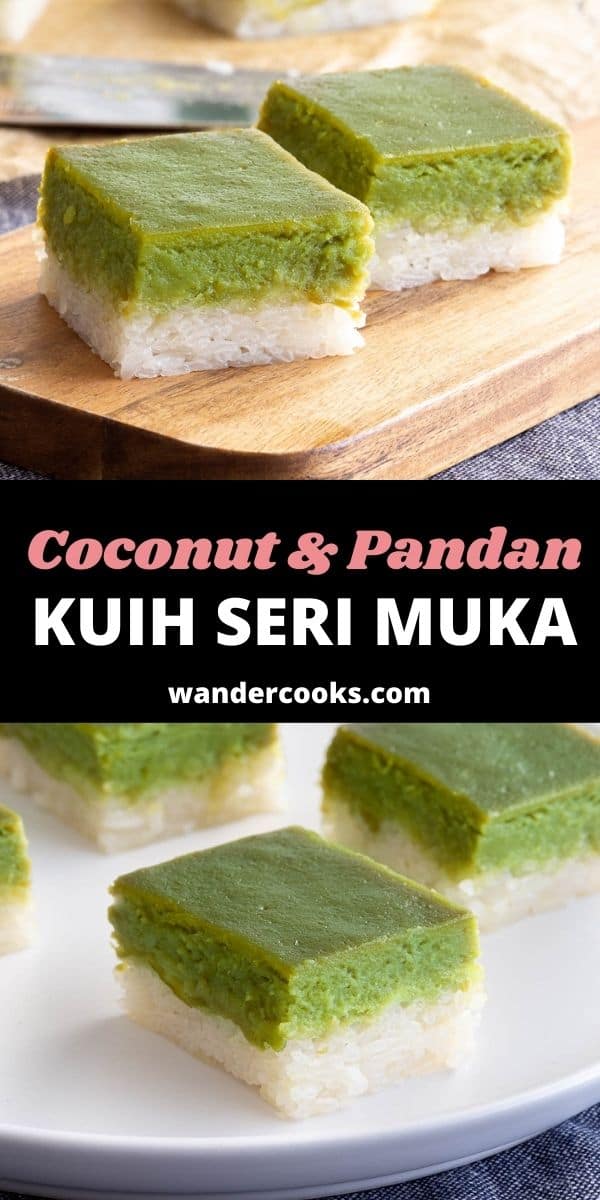

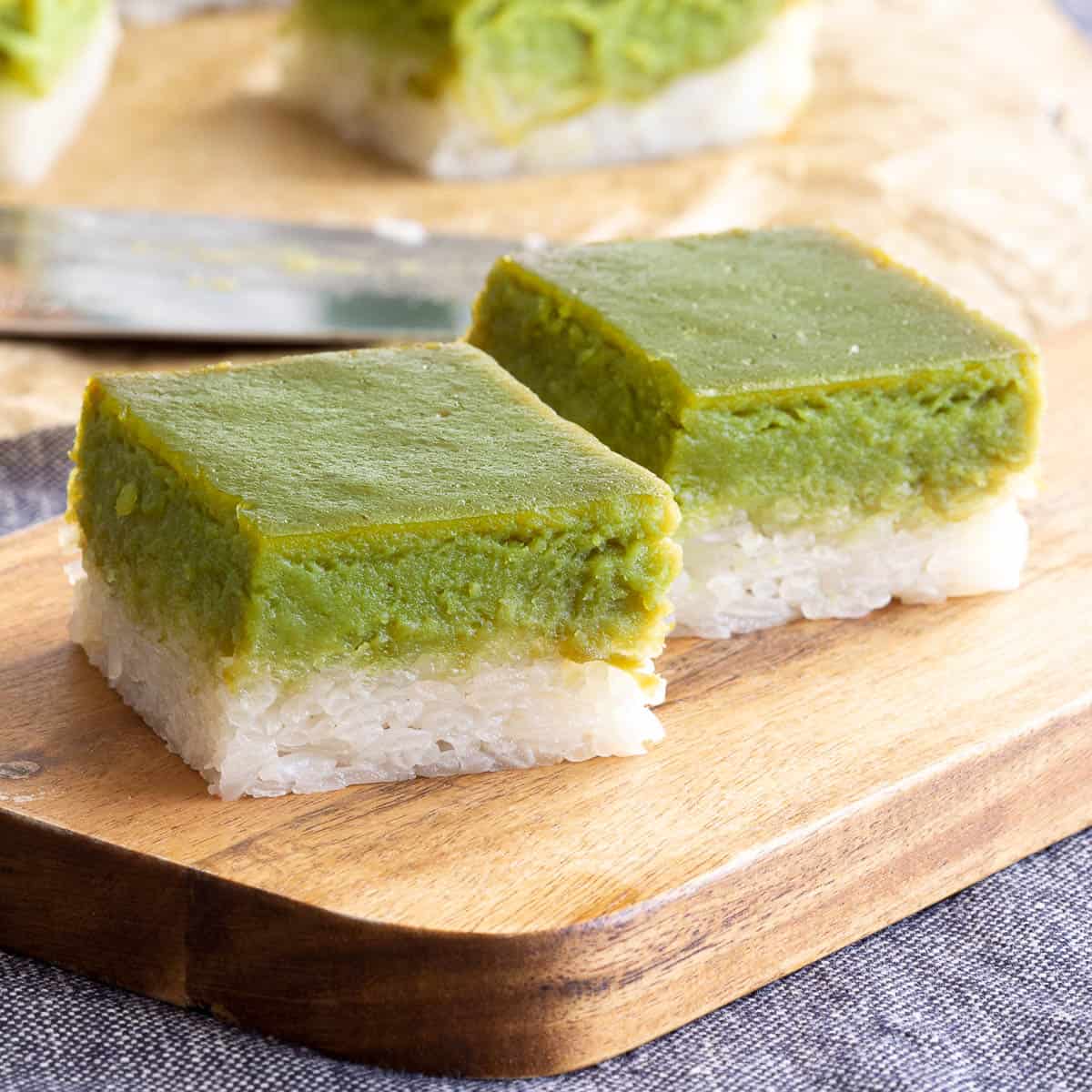


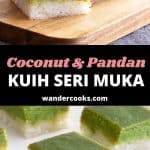
2 Comments
Norjana Mohamad
20/06/2021 at 7:58 pmI juz make this Seri muka today Request by my hubby for Father’s Day
Wandercooks
21/06/2021 at 11:15 amHey Norjana hope you all enjoyed the tasty morsels! Happy Father’s Day!